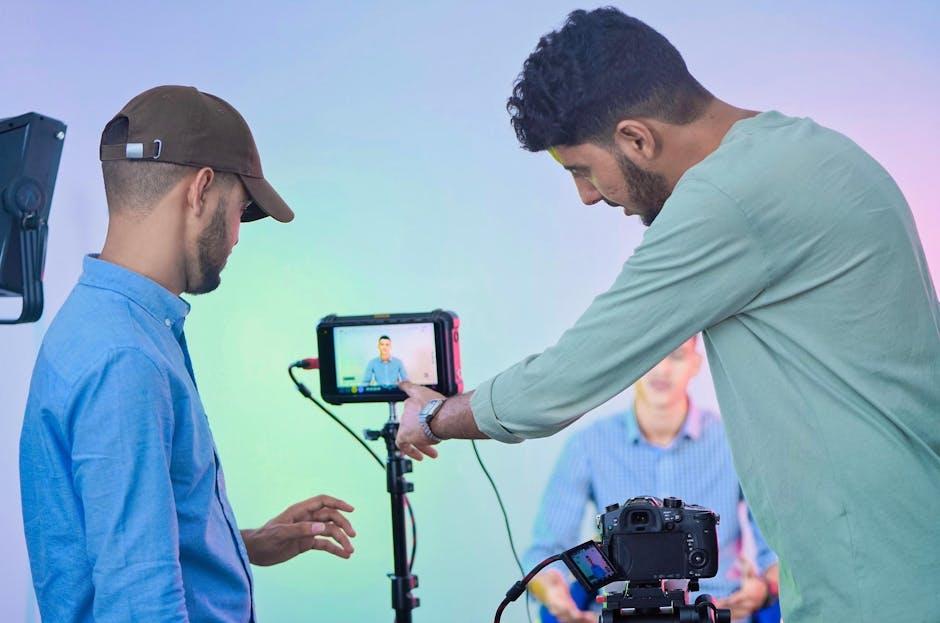In the bustling world of filmmaking, where creativity meets commerce, the producer stands at the helm, orchestrating a delicate dance between art and business. On a major film set, this pivotal role is akin to that of a maestro, harmonizing the diverse elements that bring a cinematic vision to life. With one foot firmly planted in the creative realm and the other navigating the intricate waters of budgets and logistics, producers are the unsung heroes who transform scripts into screen realities. This article delves into the multifaceted responsibilities of a producer, exploring how they balance the artistic aspirations of filmmakers with the pragmatic demands of the industry, ensuring that every frame captivates audiences while adhering to the bottom line. Producer’s Artistic Vision”>
Producer’s Artistic Vision”>
Navigating the Creative Chaos: A Producer’s Artistic Vision
In the whirlwind of a major film set, a producer’s role is akin to that of an orchestra conductor, weaving together the chaotic symphony of creativity and commerce. Their artistic vision is not just about the end product but also about nurturing the environment where art can flourish. This means understanding the nuances of each department, from costume design to cinematography, and ensuring they have the resources and support to push creative boundaries.
Producers must often make crucial decisions that affect the film’s artistic direction while keeping a keen eye on the budget. This balancing act involves:
- Collaborating with Directors: Facilitating a shared vision while respecting the director’s creative authority.
- Encouraging Innovation: Providing space for new ideas and techniques to emerge, even when they challenge conventional norms.
- Maintaining Harmony: Resolving conflicts that arise from artistic differences, ensuring that the creative process remains productive.
Ultimately, a producer’s artistic vision is about crafting a narrative that resonates with audiences, all while navigating the intricate dance between artistic dreams and practical realities.
Mastering the Budget: Financial Strategies for Film Success
Producers are the linchpin of any successful film, orchestrating a delicate dance between the creative and financial realms. Crafting a budget is more than just numbers on a spreadsheet; it’s about making strategic decisions that allow the artistic vision to flourish while ensuring financial viability. This involves allocating resources wisely, negotiating contracts, and finding innovative solutions to unforeseen challenges. A producer must possess a keen understanding of both the artistic process and market trends, ensuring that the project stays true to its creative goals while appealing to potential investors and audiences.
- Resource Allocation: Prioritize spending on elements that directly impact the film’s quality, such as talent, special effects, and key locations.
- Cost Management: Implement strategies like tax incentives, co-productions, and efficient scheduling to maximize financial resources.
- Risk Mitigation: Balance the artistic risks with financial safeguards, ensuring the project remains sustainable even in the face of unexpected hurdles.
 Actors, and Crew”>
Actors, and Crew”>
Building Bridges: Harmonizing Directors, Actors, and Crew
On a bustling film set, the producer plays a pivotal role in fostering collaboration among directors, actors, and crew. This requires a keen understanding of the creative vision, as well as the practical constraints of the production. By acting as a bridge, the producer ensures that the director’s artistic goals are realized without compromising the logistical and budgetary frameworks.
- Facilitating Communication: Producers mediate discussions, ensuring that everyone’s voice is heard and respected.
- Aligning Objectives: They work to align the artistic goals with the technical capabilities, ensuring harmony between creative ambition and practical execution.
- Resolving Conflicts: When tensions arise, producers step in to diffuse situations, finding solutions that satisfy both creative and operational needs.
By nurturing these relationships, producers not only enhance the efficiency of the production but also contribute to a more cohesive and inspired final product. Their ability to balance the intricacies of human dynamics with the demands of filmmaking is crucial in bringing a film to life.

Problem Solving on Set: Proactive Approaches to Common Challenges
On a bustling film set, producers often face a myriad of challenges that require swift and strategic problem-solving. A proactive approach involves anticipating potential issues before they arise, allowing for smoother operations and creative flow. Communication breakdowns can be minimized by establishing clear channels from the outset, ensuring that everyone from the director to the crew is on the same page. Similarly, having a contingency plan for technical glitches can save valuable time and resources.
Another critical aspect is managing the delicate balance between creative vision and budget constraints. Producers can navigate this by fostering a collaborative environment where all departments feel heard and valued. Strategies include:
- Regular check-ins with department heads to align on priorities.
- Flexible budgeting, allowing for creative solutions without compromising quality.
- Encouraging innovation, empowering team members to propose cost-effective alternatives.
By adopting these proactive measures, producers can effectively steer the production towards a successful completion, harmonizing both business and artistic goals.

